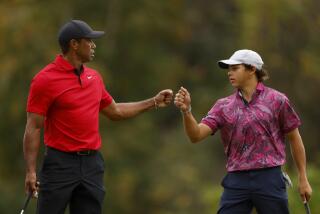American golf and tennis players are shrinking from the world stage
- Share via
Where are the Americans in the world’s most prominent individual sports, golf and tennis?
Not on the leaderboards very often.
The sports’ next majors begin soon — the U.S. Open men’s golf championship on Thursday at Congressional Country Club in Bethesda, Md., and Wimbledon at the All England Lawn Tennis Club on Monday — and there doesn’t seem much reason to expect an American winner.
On turf where, in the not-too-distant past, Americans dominated, they now mostly founder.
Last month, for the first time in the 38-year history of tennis rankings, no American man or woman was in the top 10. In the last major, the French Open, won by Spain’s Rafael Nadal (men) and China’s Li Na (women), no American even made it to the second week of play.
In golf, Britain’s Luke Donald became the top-ranked men’s player in the world two weeks ago. Since Tiger Woods surrendered that spot last October for the first time in more than five years, Germany’s Martin Kaymer and Britain’s Lee Westwood are others who have held the top spot.
No American holds a major title on the men’s tour. Northern Ireland’s Graeme McDowell is the defending U.S. Open champion; South Africa’s Charl Schwartzel won the 2011 Masters; Kaymer won the 2010 PGA Championship; and South African Louis Oosthuizen took the British Open last year.
At one point on Day 2 of the Masters in April, the 10 names on the leaderboard included only one American — 51-year-old Fred Couples.
Charles Howell III, an 11-year veteran of the PGA Tour, said the dominance of foreign players — Europeans in particular — was a “hot topic.”
He cited two reasons for their success: “A lot of European guys went to college in the U.S. Paul Casey went to Arizona State, Luke Donald went to Northwestern, Graeme McDowell went to [Alabama Birmingham]. I find it all funny the commentary on the Europeans doing so well when they’re coming here for college.”
Also, Howell said, it was wrong to have expected the so-called Tiger Woods Effect to be a factor only in the United States.
“Tiger made golf popular around the world,” Howell said. “Martin Kaymer looked up to Tiger; the Tiger influence didn’t stop in America.”
Nor was Annika Sorenstam’s effect on the women’s game felt only in Europe and the United States, said Sandra Gal of Germany, who won her first LPGA tournament title last winter in the City of Industry.
“I think a lot of women around the world watched Annika and became interested,” Gal said of the Swedish star who became an American citizen in 2006. “I know some of the girls I’ve spoken to from Korea say that too.”
American women have not fallen as far off the golf radar as the men. Cristie Kerr, who won the last LPGA Championship, is second in the world rankings behind Yani Tseng of Taiwan. Also, Paula Creamer won the last U.S. Open and 26-year-old Texan Stacy Lewis won the Kraft Nabisco Championship, this year’s first major.
But there are only two Americans in the top 10 of the Rolex Rankings — Kerr and Michelle Wie, who is 10th. Six of the top 10 women are from Asia — Taiwan, Japan or South Korea.
Only five years ago, when the women’s world golf rankings debuted, Sorenstam was No. 1 and Americans Creamer, Wie and Kerr were second, third and fifth.
In men’s golf, Americans Woods, Phil Mickelson and Steve Stricker were ranked 1-2-3 at the end of 2009, and Jim Furyk was No. 6. Now Stricker, at No. 4, leads the way.
In tennis, U.S. women — sisters Serena and Venus Williams, Lindsay Davenport and Jennifer Capriati in some combination — owned the top three spots in the world rankings throughout 2001 and 2002. Now, Serena Williams, at No. 25, is the highest-ranked American woman. Venus is next at No. 32.
The best of the American men are No. 9 Mardy Fish and No. 10 Andy Roddick, whereas in 1995 the U.S. held the Nos. 1, 2, 5, 8 and 18 spots with Pete Sampras, Andre Agassi, Michael Chang, Jim Courier and Todd Martin.
The reason for this gradual erosion?
In preparation to write his book “The Talent Code,” author Daniel Coyle traveled the world to see why athletes from Europe and Asia were doing so well. He said he discovered one universal truth: “It’s pretty simple. You practice more, you get better.”
“Here in the U.S., we’ve fallen in love with the idea that athletic talent is a gift,” he said. “That’s a beautiful idea, that a baby is born with a gift, that a Michael Jordan had a divine spark, or that Serena Williams is so gifted that she can just go out and sell tennis shoes. But guess what? Turns out, that idea is fundamentally wrong.”
Patrick McEnroe, general manager of player development for the United States Tennis Assn., agreed with Coyle.
“We tend to look for the stars when kids are 8 or 9,” he said, “and it’s the same in leagues like Pop Warner football and baseball’s Little League. We tend to think of who can become professionals and the kids start thinking that way.”
McEnroe’s point was that picking out an American prospect at age 10 sometimes means instant sponsorship money and sudden media attention that doesn’t translate into accepting the intense training found elsewhere around the world.
It is that sort of training that has sent Purdue golf Coach Devon Brouse recruiting far from home. His women’s team won the 2010 NCAA championship and finished second to UCLA this year with one American-born woman on his roster.
“The international kids are more appreciative of the opportunity,” Brouse said. “In some cases they are more mature, hungrier. For me, right now, to compete at the high level, it’s more desirable for me to recruit internationally.”
Brouse said he recruits mostly by looking at results from international junior events and networking with coaches of national teams around the world.
Golfers in Europe and Asia, Brouse said, also get help because governments subsidize national teams, which helps developing talent to compete internationally without incurring personal financial burdens.
“Constantly I have parents asking me why international athletes are taking scholarships away from ‘our’ kids. They have resentment,” Brouse said. “I tell them we’re in a competitive world.
“My job is to win championships. I’m supposed to represent our university as well as I can, and part of that is winning championships. We won it in 2010. I couldn’t have done it with all American girls.”
There is hope for the future, though.
Jessica Korda, 17, from Florida, qualified for the LPGA tour in December. She is the daughter of former Czech tennis star Petr Korda. Alexis Thompson tied for 10th at last year’s U.S. Open as a 15-year-old.
And, as Howell said, “It’s only a matter of time” before Rickie Fowler, 22, from Murrieta, begins winning big. Fowler qualified for the Ryder Cup team last year.
In tennis, McEnroe said there is a “large crop” of 13- and 14-year-old American females who will make a mark. McEnroe didn’t want to name names, but several participated in a USTA Challenger tournament in Carson two weeks ago, including Gabby Andrews, 14, of Pomona, who earned her first WTA computer points by beating a 24-year-old professional.
Andrews is the youngest direct entrant into the women’s junior Wimbledon event that begins next week, earning that spot by winning the prestigious 18-under title at the Easter Bowl tournament, her third career national 18-under title.
Her father, Michael, said he’s been happy keeping his daughter under the radar, though at the USTA event, Octagon, the world’s second-largest sports agency, was courting Gabby.
“I just want to take it one step at a time,” she said.
Her goal is not to be the next Serena or Venus Williams.
“You can’t think like that,” Gabby said. “That just traps you. I need to keep getting better.”
At the Carson Challenger, half of the round of 16 were American teenagers. Michael Joyce, who coached Maria Sharapova and who is now mentoring 17-year-old Jessica Pegula, said that although he didn’t see any soon-to-be stars among young American men, the women’s future was bright.
“Gabby’s got talent, Jessica, [15-year-old] Taylor Townsend, these girls can play,” Joyce said.
Each young woman is taking a different path. Andrews is being coached by her father at her home club in Claremont; Townsend is using USTA coaches; Pegula has signed on with Joyce.
And, for the first time since John McEnroe in 1977, an American boy won the French Open junior title — Bjorn Fratangelo, 17, from Pittsburgh.
Fratangelo, of course, was named after a former tennis star — though not an American one.
His father was a huge fan of Sweden’s Bjorn Borg.
twitter.com/mepucin
More to Read
Go beyond the scoreboard
Get the latest on L.A.'s teams in the daily Sports Report newsletter.
You may occasionally receive promotional content from the Los Angeles Times.










